Viruses
1/42
There's no tags or description
Looks like no tags are added yet.
Name | Mastery | Learn | Test | Matching | Spaced |
|---|
No study sessions yet.
43 Terms
What is a virus ?
A virus is an obligate parasite, unable to complete its life cycle without exploiting a suitable host, relying on the host's cellular machinery for replication.
What are the structural components of a virus
Viruses are composed of:
Nucleic acids (DNA or RNA, not both)
Surrounded by a capsid (protein coat)
Potentially with a lipoprotein envelope or carbohydrate layer.
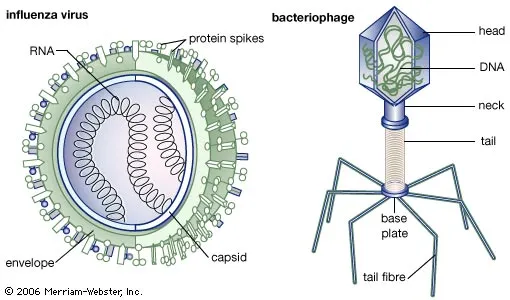
What types of nucleic acids can viruses contain
Viruses can contain either contain DNA or RNA
DNA:
Linear single-stranded e.g., B19
Linear double-stranded
Circular double-stranded e.g., Hepatitis B
Super-coiled double-stranded e.g., Papilloma
RNA:
Positive single-stranded non-segmented e.g., Polio
Negative single-stranded linear e.g., Rabdo
Positive single-stranded segmented e.g., HIV
Negative single-stranded segmented e.g., Rabdo), but not both.
—
Positive-sense RNA (+RNA): This type of RNA can be directly translated by the host cell's ribosomes into proteins, acts as mRNA in the host cell.
Negative-sense RNA (-RNA): This type of RNA is complementary to the mRNA and cannot be directly translated into proteins. Must first be converted into a positive-sense RNA by an RNA-dependent RNA polymerase before it can be translated.
What is a helical capsid
A helical capsid is made of protein monomers (protomers) that self-assemble into a helix, efficiently enclosing nucleic acid.
In RED
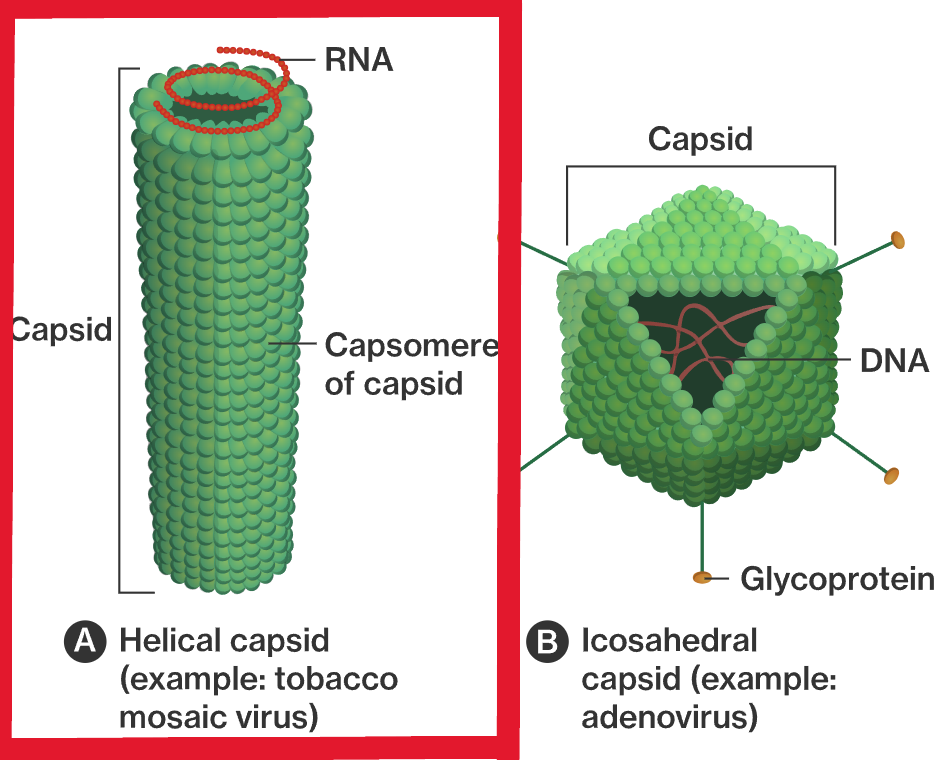
What is an icosahedral capsid
An icosahedral capsid is polyhedral in shape, formed by pentamers and hexamers, providing the most efficient way to enclose space.
In RED
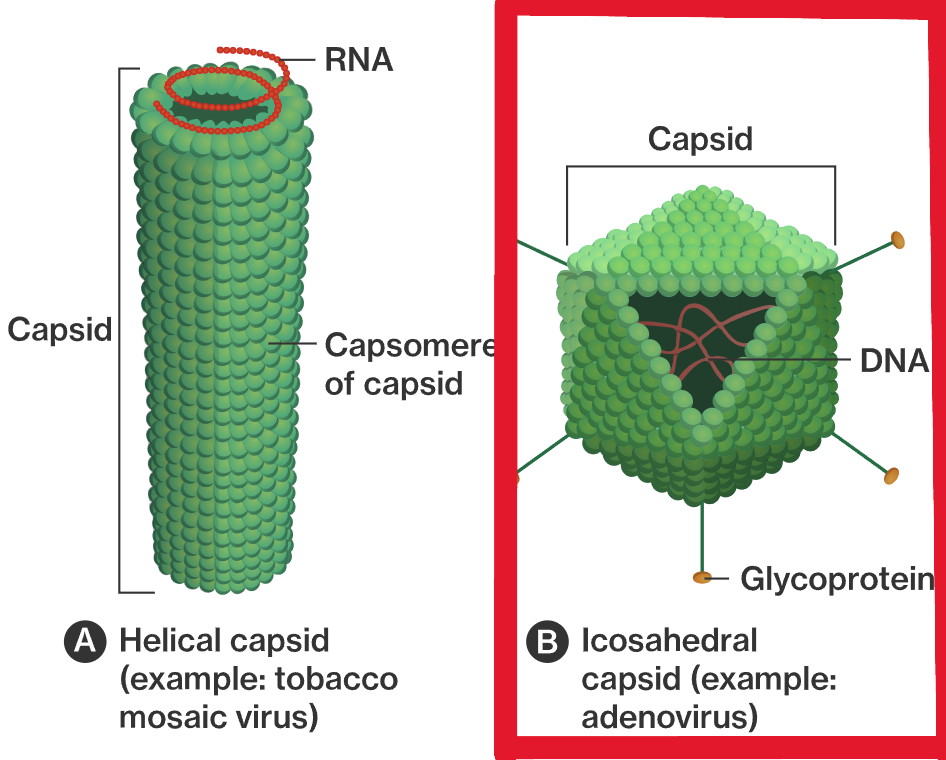
What is the role of a viral envelope
A viral envelope, derived from the host cell membrane, contains:
Hemagglutinin spikes for attachment to host receptors
Neuraminidase spikes to break down mucous, aiding transmission via membrane fusion (virulence factor).
How does COVID-19 enter host cells
COVID-19's nucleic acid is surrounded by a capsid with spike proteins binding to the ACE2 receptor, entering via endocytosis
Escape relies on a pH-dependent process inhibited by chloroquines, reducing infection.
What is complex symmetry in viruses
Complex symmetry refers to the structural organization that COMBINES multiple types of symmetry (e.g., icosahedral and helical) WITHIN a SINGLE viral particle.
—
Complex symmetry, seen in bacteriophages, features:
Icosahedral head
Helical collar
Tail fibers for attachment to bacterial cell surfaces (Only infect bacteria, not human cells)
—
Unlike viruses with simple symmetry (e.g., purely icosahedral like adenoviruses or helical like tobacco mosaic virus), complex symmetry involves distinct structural components that work together to form a more intricate architecture. [Bacteriophages]
![<p>Complex symmetry refers to the structural organization that <strong><mark data-color="purple" style="background-color: purple; color: inherit">COMBINES</mark></strong> multiple types of symmetry (e.g., icosahedral and helical) <strong><mark data-color="purple" style="background-color: purple; color: inherit">WITHIN</mark></strong> a <strong><mark data-color="purple" style="background-color: purple; color: inherit">SINGLE</mark></strong> viral particle.</p><p>—</p><p>Complex symmetry, seen in <mark data-color="purple" style="background-color: purple; color: inherit">bacteriophages</mark>, features:</p><ul><li><p><strong><mark data-color="blue" style="background-color: blue; color: inherit">Icosahedral head</mark></strong></p></li><li><p><strong><mark data-color="blue" style="background-color: blue; color: inherit">Helical collar</mark></strong></p></li><li><p><strong><mark data-color="blue" style="background-color: blue; color: inherit">Tail fibers</mark></strong> for attachment to bacterial cell surfaces<mark data-color="purple" style="background-color: purple; color: inherit"> </mark><strong><em><mark data-color="purple" style="background-color: purple; color: inherit">(Only infect bacteria, not human cells)</mark></em></strong></p></li></ul><p>—</p><p>Unlike viruses with simple symmetry (e.g., purely icosahedral like adenoviruses or helical like tobacco mosaic virus), complex symmetry involves distinct structural components that work together to form a more intricate architecture. <mark data-color="purple" style="background-color: purple; color: inherit">[Bacteriophages]</mark></p>](https://knowt-user-attachments.s3.amazonaws.com/9e51340f-d348-4587-a638-683527456e1d.png)
What are the steps of the lytic process in bacteriophages
Lytic process:
1. Attachment to the bacterial cell surface.
2. Injection of nucleic acid via enzyme-mediated breakdown of cell walls/membranes.
3. Degradation of host DNA.
4. Replication of viral components.
5. Host cell lysis releasing new viruses.
How can bacteriophages treat bacterial infections
By lysing the bacteria during the lytic cycle, Bacteriophages can treat antibiotic-resistant bacterial infections (e.g., E. coli causing UTIs, gram-negative, rod-shaped)
What occurs during the lysogenic phase of bacteriophages
Lysogenic phase:
Viral DNA integrates into the host chromosome
Remaining dormant for a period
The cell divides and prophage DNA is passed onto the daughter cells
Under stressful conditions the prophage DNA is excised from the bacterial chromosome and enters the lytic cycle
Phage DNA replicates and phage proteins are made
New phage particles are assembled
The cell lyses, releasing the newly made phages.
Before potentially switching to the lytic cycle, as seen with influenza.
What are the stages of the viral growth curve? How is this different to a bacterial growth curve?
1. Inoculation: Drop in detectable viruses as they enter host cells.
2. Eclipse: Replication of viral components (DNA, capsids) in a logarithmic fashion.
3. Burst: Host cell bursts, releasing many viral particles (burst size remains constant as viruses aren't alive)
—
Bacterial = Lag / Log (Exp.) / Stationary / Death
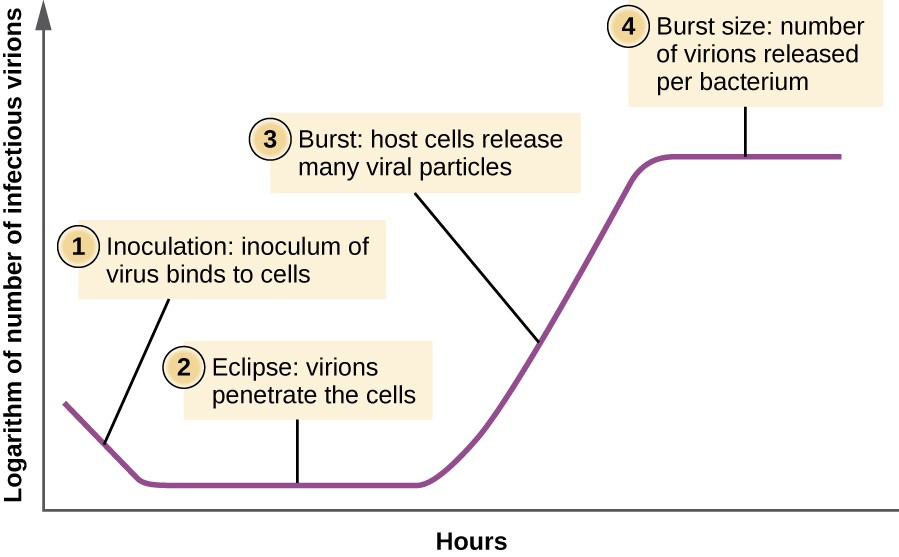
How does adsorption occur in eukaryotic virus reproduction
Adsorption is the initial stage in viral infection where a virus (virion) attaches to the surface of a host cell
Adsorption involves random collisions between the virion and plasma membrane receptors (glycoproteins with functions like hormone signaling or immunity).
What are the methods of penetration for eukaryotic viruses
Eukaryotic virus Penetration:
1. Direct penetration by naked viruses (e.g., poliovirus).
2. Membrane fusion by enveloped viruses (e.g., paramyxovirus).
3. Endocytosis (e.g., HIV)."
How do DNA viruses replicate and transcribe
DNA viruses transcribe their genome to functional mRNA using host DNA-dependent RNA polymerase directly read by the ribosomes to synthesise viral proteins
—
Smaller viruses (e.g., parvoviruses) lack biosynthetic enzymes and are fully host-dependent
Larger viruses (e.g., poxviruses) have their own polymerase.
Describe the replication of eukaryotic viruses? [Not alive]
1) Adsorption
Random collisions occur between virion and plasma membrane receptors
The receptors are glycoproteins with an essential function (e.g. for hormones / immunity) e.g. in HIV for CD-4 receptors
2) Penetration
Various ways for penetration:
a. Direct penetration by naked viruses e.g. poliovirus
b. Enveloped viruses fusing with plasma membrane e.g. SARS-CoV-2
c. Entry by endocytosis
3) Replication & Transcription
Genome must be transcribed to functional mRNA and use host DNA dependent RNA polymerase (usually hijacking from the host as they don’t have the enzyme themselves)
—
The smaller the virus, the more dependent the virus is on the host cell (less protein to encode itself)
Parvoviruses (small virus) has no biosynthetic enzyme so must use host
Poxviruses (slightly larger virus) has its own DNA dependent RNA polymerase II to make their mRNA
(+ve) SSe.g. Polio → can be used as mRNA directly
(-ve) SS e.g. Rabdo → must synthesise mRNA through a viral associated transcriptase and it encodes its own enzyme for this
DS e.g. reoviruses → has transcriptase copies which converts to -ve strand
Retroviruses e.g. HIV
RNA virus that go through a DNA intermediate before transcription and translation process
RNA viruses can contain +ssRNA that can be directly read by the ribosomes to synthesise viral proteins.
Viruses containing -ssRNA must first use the -ssRNA as a template for the synthesis of +ssRNA before viral proteins can be synthesised
Retroviruses are +ssRNA (+ve strand so theoretically should encode directly)
e.g. HIV encode reverse transcriptase within the capsid that synthesises a complementary ssDNA (cDNA) copy using the +ssRNA genome as a template and RNA degrades.
The ssDNA is then made into dsDNA (complementary strand is made then giving double strand DNA which can be integrated into the host becoming permanent part of the host (~10yrs until target cell (target cell has CD4 receptor for HIV) has been exhausted)) which can integrate into the host chromosome and become a permanent part of the host. The integrated viral genome is called a provirus.
This method allows continuously replication of virus genome every time the host cell replicates which prevents extinction of virus
[1 cell is infected and then many cells get infected (daughter cells of mother cell)]
How do RNA viruses with positive single-stranded RNA replicate
Positive single-stranded RNA (+ssRNA) viruses (e.g., Polio) can be directly read by host ribosomes as mRNA to synthesize viral proteins.
Via Translation where the mRNA sequence is used to synthesize a protein. This occurs at ribosomes in the cytoplasm.
How do RNA viruses with negative single-stranded RNA replicate
Negative single-stranded RNA (-ssRNA) viruses (e.g., Rabdo) use viral RNA-dependent RNA polymerase (RdRP) to synthesize +ssRNA from the -ssRNA template before protein synthesis
Via Transcription AND Translation
How do double-stranded RNA viruses replicate
Double-stranded RNA viruses (e.g., reoviruses) use transcriptase to copy the negative strand into mRNA for protein synthesis.
How do retroviruses replicate
Retroviruses (e.g., HIV):
Encode reverse transcriptase to synthesize a complementary ssDNA (cDNA) from +ssRNA
Degrade RNA,
Form dsDNA, integrating it into the host chromosome as a provirus via homologous integration
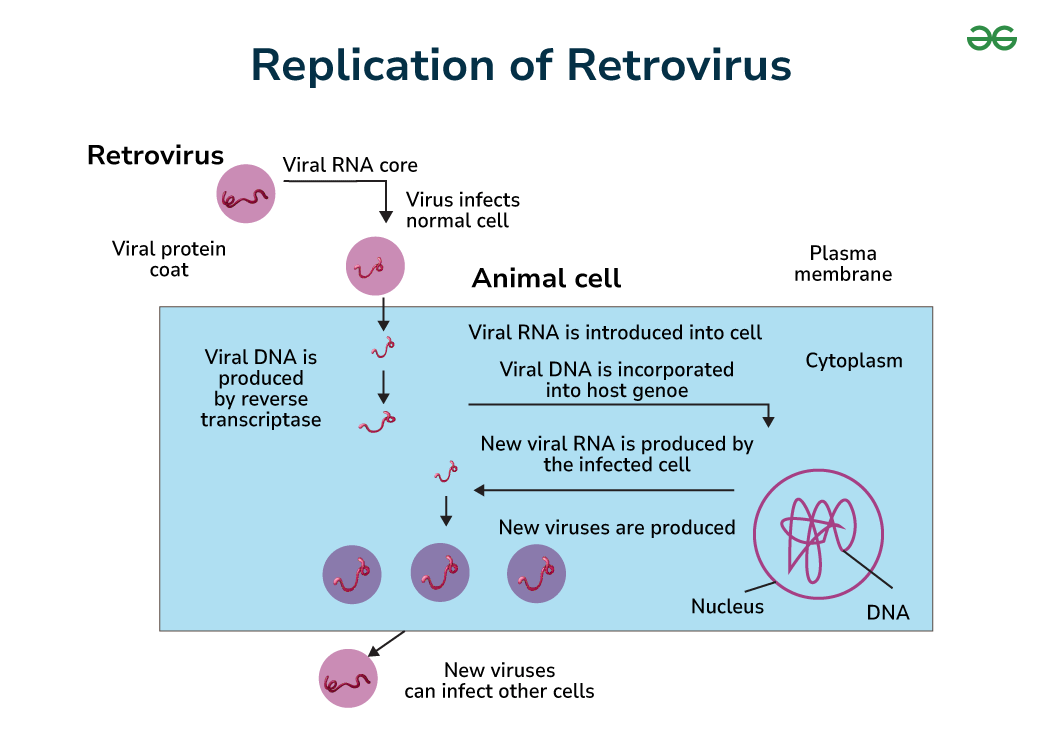
What is the impact of HIV replication on the immune system
HIV overwhelms CD4 receptors:
Causes clonal antibody exhaustion
Compromises the immune system
Leading to opportunistic infections
How are viruses cultured
Cultured using fertilized chick embryos (different components for different viruses)
or
Lawns of bacteria with bacteriophages to create plaques for identification
Bursal cells
Aids vaccine production
What characterizes acute viral diseases
Rapid onset and high affinity (influenza (orthomyxoviruses))
Typically spread by inhalation, with capsid spikes causing receptor-mediated endocytosis in epithelial cells.
What aspects of acute viral diseases causes symptoms? [influenza]
Caused by:
NK cells and activated CD8+ T-cells killing infected cells
With fatal secondary infections like acquired pneumonia possible.
What is a latent viral infection
A latent viral infection, like chickenpox (varicella-zoster virus), involves the virus becoming dormant after the primary infection, reactivating later (e.g., as shingles) due to triggers like stress or weakened immunity.
How does chickenpox progress to shingles
Chickenpox (primary infection) causes a vesicular rash
The varicella-zoster virus migrates to dorsal root ganglia (spinal nerves) and becomes latent.
Reactivation (shingles) occurs later, traveling down sensory nerves, causing a painful, localized rash in a dermatome.
How is hepatitis B transmitted
"Hepatitis B (HBV, a DNA virus) is transmitted via direct contact with infected blood/body fluids (e.g., transfusions, needlesticks, mother-to-child) or sexual contact."
What is the disease progression of hepatitis B
"Hepatitis B can be acute (self-resolving in most cases) or chronic (10% of cases), persisting in the liver, with carriers remaining infectious asymptomatically."
What are the complications of chronic hepatitis B
"Chronic hepatitis B carriers (e.g., 250,000 in the UK) risk cirrhosis (liver scarring) and hepatocellular carcinoma (liver cancer) due to severe liver damage over time."
How is hepatitis B managed
Though no cure exists:
Hepatitis B is prevented with a highly effective vaccine [Hepatitis B vaccine](recommended for high-risk groups like healthcare workers)
Chronic cases are managed with antivirals to reduce replication
What are slow viral diseases
Slow viral diseases have long incubation periods (years/decades) before symptoms
Primarily causing neurological deterioration, leading to severe, irreversible damage.
What is post-infectious encephalopathy
A rare delayed neurological condition from measles
With symptoms like cognitive decline, seizures, and motor dysfunction years after infection.
—
Post-infectious encephalopathy, like subacute sclerosing panencephalitis (SSPE)
What are prion diseases
Prion is a misfolded rogue form of normal protein found in the cell.
Are not viruses, but a mutated protein
Misfolded proteins are: Insoluble / Resistant to breakdown / Accumulate in brain tissue, causing neuron damage and spongiform encephalopathies / spongiform (sponge-like) degeneration. - Mad Cow disease
—
Proteinaceous Infectious Particle
PrPᶜ (cellular): Normal prion protein (non-pathogenic)
PrPˢᶜ (scrapie): Misfolded, disease-causing version
Endogenous normal prion protein (PrPc) is converted to disease causing form (PrPsc) when it encounters this variant form of the protein in a chain reaction.
There is no treatment / vaccine / diagnostic test for prions so we can only track back and confirm that the animal/ meat has not been in contact with a prion.
How do prions function
Abnormal Prions (PrPˢᶜ) convert normal prion proteins (PrPᶜ) into abnormal, stable forms without DNA/RNA involvement, accumulating in neural tissue and causing brain damage (neurotoxicity).
—
(PrPˢᶜ) is structurally stable because it resists:
Heat
Protease digestion
Denaturation
Making it hard to destroy, even with standard sterilization techniques.
How are prions transmitted
Prions are transmitted via ingestion of infected tissue (e.g., brain), blood transfusions or contaminated equipment
They resist standard sterilization (heat, chemicals).
Why are prions challenging to detect
"No definitive test exists for prions in raw materials or products; manufacturers rely on supplier certifications of low risk, managed through regulatory guidelines."
What is phage therapy
Phage therapy uses bacteriophages to treat bacterial infections, a promising approach against antimicrobial resistance (AMR)
What types of cells can viruses infect
Viruses infect cells in:
Plants
Animals
Fungi
Protists
Bacteria
Archaea
with limited host ranges and specific cell type preferences.
How are viruses classified
Viruses are classified by:
Morphology (helical, polyhedral, complex)
Nucleic acid type (DNA/RNA)
Host range
Cell specificity
Enzymes within the virion
—
Diseases are coded using ICD codes.
What are the stages of viral infection in host cells
1. Attachment. - Virus becomes attached to a target cell.
2. Penetration. - Cell engulfs / uptakes the virus by endocytosis
3. Uncoating. - Viral contents are released.
4. Biosynthesis. - Viral RNA enters the nucleus where it is replicated by the viral RNA polymerase.
5. Maturation. - New phage particles are assembled.
6. Release. - New viral particles are made and released into the extracellular fluid. The cell, which is not killed in the process, continues to make new viruses.
How do bacteriophages differ from animal viruses in entry
Bacteriophages inject DNA into host cells BUT animal viruses enter via endocytosis or membrane fusion
Bacteriophages have lytic or lysogenic cycles BUT animal viruses can enter latency.
What is the growth curve of bacteriophages
"Bacteriophage growth is a one-step multiplication curve (inoculation, eclipse, burst), not sigmoidal like bacterial growth, with a constant burst size."
What are the properties of prions as infectious agents
"Prions are proteinaceous infectious particles causing transmissible spongiform encephalopathies, highly resistant to chemicals, heat, and radiation, with no treatments available."